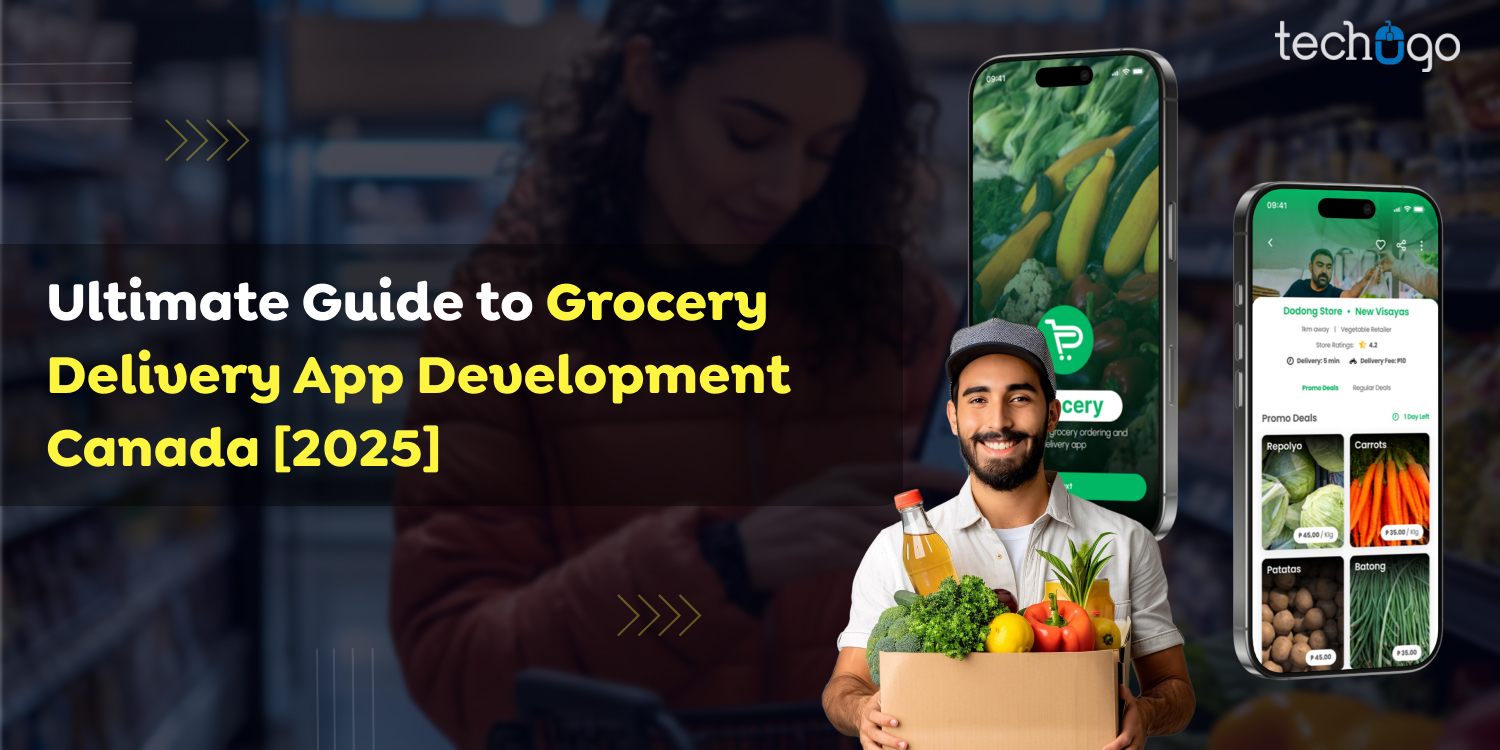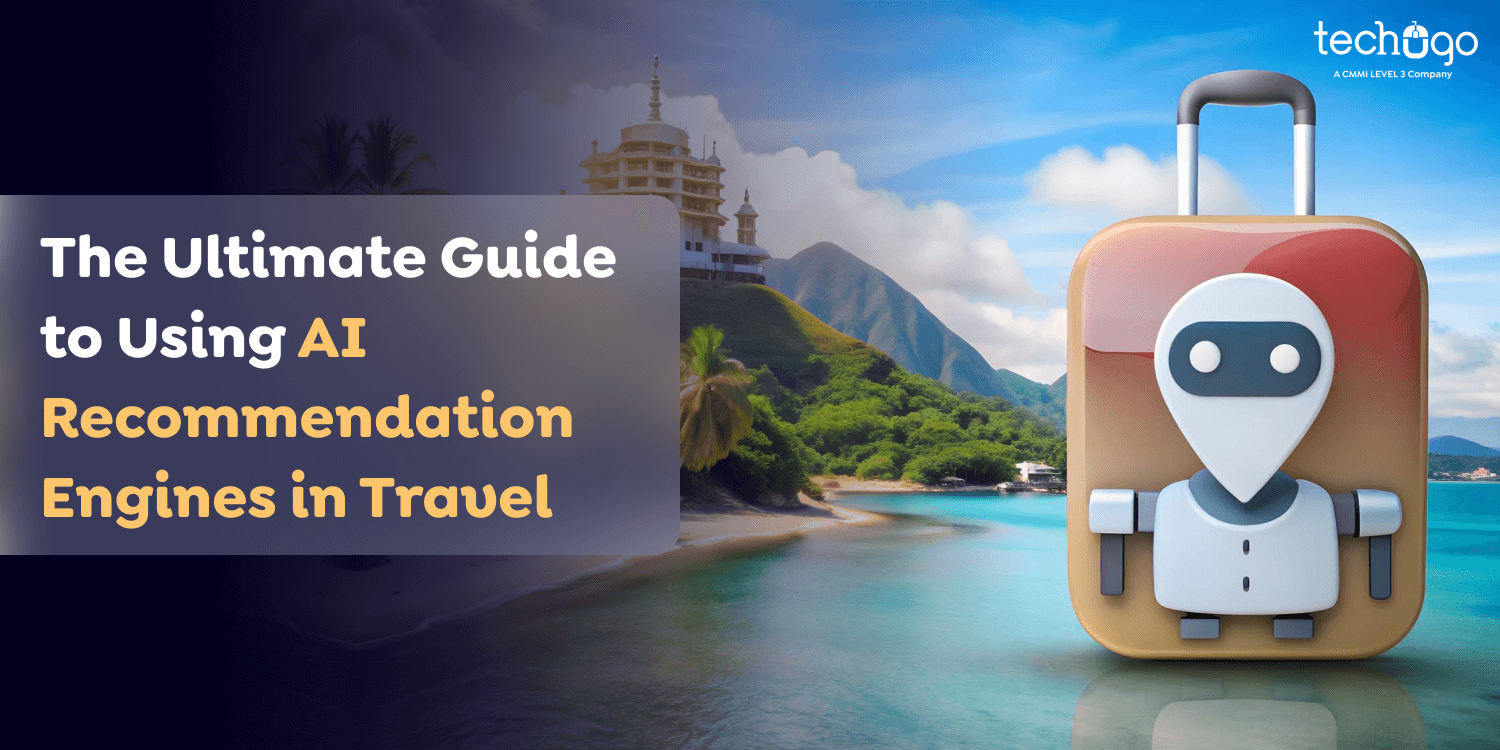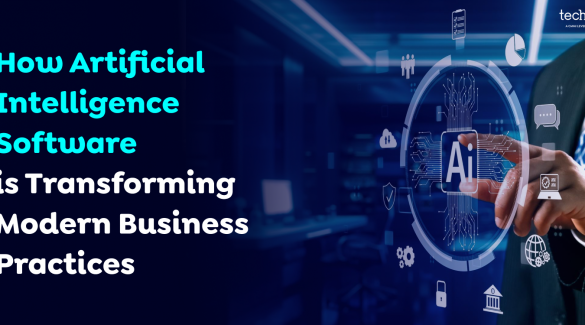14 Feb 2025
Ultimate Guide to Grocery Delivery App Development Canada [2025]
Matthew Connor

The delivery of grocery items is becoming the norm for many families who depend on it for their daily necessities. Due to the advancement of grocery delivery apps, shopping for groceries has shifted to online platforms. This shift has transformed businesses and allowed them to better serve modern consumers.
As time passes, demand for grocery delivery app development solutions is gaining momentum, with entrepreneurs and businesses trying to capitalize on this growing market. The grocery delivery industry in Canada is expected to reach an annual revenue of $7.57bn by 2025. The market is expected to reach an annual rate of 9.39% (CAGR 2025-2029), reaching an estimated market size of $10.84bn by 2029.
With the new trend of 10-minute grocery delivery gaining popularity, the demand for such applications is rising. Whether you’re an entrepreneur, the manager of a smaller store, or part of a major department store chain hoping to profit from the rapid growth in commerce, now is the right time to get started!
However, one of the biggest challenges is the complex development process. Grocery delivery app development involves several stages, including planning, building the app, testing, and launching it. The challenge of creating and implementing apps that can compete with marketplace leaders requires a strategic approach.
This article will guide you through everything you need to know about creating a grocery delivery app for your business.
What Are Grocery Delivery Apps?
Customer habits for grocery shopping have dramatically changed. While there has always been a need to purchase goods online, grocery shopping is now highly convenient due to recent shifts in consumer behavior. Grocery shopping habits worldwide are changing as people buy essentials grocery items from the comfort of their homes.
A grocery delivery app is a kind of application that allows customers to purchase grocery items online. App owners are responsible for facilitating the delivery of grocery items to users’ homes based on the app’s terms and conditions. Most grocery apps follow a subscription model, requiring users to pay monthly or annual fees, in addition to the cost of the groceries purchased on the platform.
It’s a simple app that lets users buy grocery items right from their homes. It’s similar to an online marketplace but with faster delivery and food options. The app lets you explore a virtual catalog of products available from various retailers, add them to your shopping cart, pay directly, and wait for the delivery driver to bring the package. In addition to this basic functionality, modern grocery delivery apps typically include GPS-based order tracking and personalization tools that use AI or machine learning.
Types of Grocery Delivery Apps
If you’re developing a grocery application for a startup, it’s important to understand the main types of grocery delivery apps. If you’re new to this field, this will help you understand the types of apps you can develop. These apps also demonstrate different business models. Let’s take a look at the various types:
Aggregator Grocery Delivery App
These apps operate on an aggregator business model. They partner with various supermarkets in nearby locations, offering a wide selection of items from a single app. Users can buy products from several top stores through one app, eliminating the need to visit multiple locations. Once the user confirms payment, the retailer or delivery staff will deliver the groceries directly to the customer’s door.
Multi-Vendor Marketplace App
A multi-vendor marketplace app functions as a platform where vendors can connect with customers. Vendors can list their offerings, showcase items, run discounts, and more. Grocery delivery apps that function like multi-vendor marketplaces are similar to aggregator apps but have different functions. For example, you’ll need a delivery crew to transport goods to the customer’s location, similar to how Amazon operates.
Grocery Chain App
Grocery delivery apps chains allow businesses to scale. From listing merchandise to shipping products to customers, everything is managed by your team. You can create online delivery services across cities or other locations, just like grocery chains such as Walmart.
Single Store Grocery Delivery App
Want to take your brick-and-mortar store online? One of the best options is white-label app development for grocery delivery. This app is specifically designed for a single retailer, helping you expand your business and increase revenue.
Benefits of Building Grocery Delivery Apps
In today’s digitally connected society, the rise of grocery delivery apps has become essential rather than an expense for those in the food industry. Here are the top reasons why businesses should consider developing grocery delivery apps:
Time and Cost Efficiency
Operational expenses related to checkout and customer service processes can be significantly reduced. Grocery delivery allows you to serve more customers without needing additional premises or employees.
By enabling customers to shop at any time, you can spread demand throughout the day, which results in better inventory control and less pressure during peak hours. Grocery delivery app features like product comparison and flexible delivery scheduling can increase average sales and encourage customers to make repeat purchases, thereby boosting revenue and profitability.
Expand Customer Reach
Grocery delivery app development services can attract new customers by offering greater personalization, convenience, and accessibility. A feature-rich app provides multiple communication channels for clients, such as email, in-app notifications, SMS, and more. By offering convenience and smooth transactions, you can foster customer loyalty, build long-lasting relationships, and expand your geographic reach, along with other advantages.
Better Inventory Control
Grocery delivery apps enable businesses to track inventory levels in real time and automatically record inventory data for reordering, while also allowing for expiry date management to reduce waste. Features like barcode scanning, multi-store management, and detailed reporting ensure accurate inventory control. This system’s efficiency can significantly increase your business’s profitability.
Operational Efficiency
A well-designed grocery delivery app that incorporates various technologies helps improve the efficiency of your business operations. Integration of an inventory control system provides real-time inventory information. Additionally, self-service features reduce the burden on your staff, improve workforce management, and enhance supply chain management. Precise data monitoring can lead to significant cost savings.
Special Offers & Loyalty Programs
Loyal customers are crucial to the success and growth of any business. However, it’s not easy to maintain loyal customers. Keeping an excellent relationship with your frequent customers is essential to make them faithful ones. By using grocery delivery apps, your customers will benefit from the services you offer by being presented with personalized recommendations and making loyalty programs work effectively.
Competitive Advantage
In a highly competitive business environment businesses must distinguish themselves against their competition. The development of a grocery delivery app can provide a substantial competitive advantage. This makes businesses appear innovative and friendly, setting aside traditional brick-and-mortar shops. By embracing the latest technology and providing the convenience of shopping via an app business can gain new customers and retain their customers they already have, and remain in ahead of their competitors.
Key Features of Grocery Delivery App Development
Here are some of the most important features that a grocery delivery app needs to have:
User Registration and Profiles
Make it easier for customers to sign up by allowing them to sign up via their social media accounts or via email. By creating profiles, customers can save their preferred preferences, delivery address, and purchase history, making it possible to customize their experience to meet their needs.
Real-Time Inventory Management
Ensure product availability by integrating a robust, automated inventory management system in real time. This feature allows customers to check stock levels, preventing the frustration of ordering out-of-stock items. It also helps businesses improve inventory management and restocking procedures, ensuring a smooth and seamless buying experience for users.
Intuitive Product Catalog
Develop a visually appealing, user-friendly interface to make browsing food items an enjoyable experience. Incorporate advanced search tools, filters, and sorting techniques to help users efficiently find the products they need. Enhance the catalog by including high-resolution product photos, detailed descriptions, pricing information, and nutritional facts, allowing customers to make informed purchasing decisions
Secure and Seamless Payment Options
Build trust and ease of use with a secure, seamless payment system. Offer various payment options, such as debit/credit cards, digital wallets, or popular local payment methods. A secure payment system not only increases user satisfaction but also protects confidential financial data.
Delivery Scheduling and Real-Time Tracking
Give customers the flexibility to select delivery times that fit their schedules. Implement real-time tracking capabilities so they can monitor the progress of their orders. Keep customers engaged by providing visual tracking maps, status updates, and estimated delivery times throughout the shipping process.
Smart Shopping Lists and Favorites
Make grocery shopping easier by allowing users to create and manage shopping lists. Customers can easily save their favorite items for quick access, making it easier to restock their shelves. Smart shopping lists can recommend items based on previous purchases or offer personalized suggestions, making shopping more efficient and convenient.
Secure Payment Gateways
Build trust and ease of use with a secure, seamless payment system. Offer multiple payment options like debit or credit cards, digital wallets, or popular local payment methods. A secure payment system not only increases user satisfaction but also protects confidential financial data.
Engaging Push Notifications and Alerts
Your customers will be delighted with prompt personalized push notifications as well as alerts. Notify them of order confirmations, updates on delivery, special discounts and personalised advice. Staying in touch with customers via engaging notifications to build customers’ loyalty and ensure that your application is at the forefront of their thoughts.
Ratings and Reviews
Allow users to share their feedback by rating and reviewing products and delivery services. Customer feedback adds credibility to your app and helps other users make informed decisions. It also offers important insights that can help businesses enhance their services and improve customer satisfaction.
Proactive Customer Support
Provide seamless, 24/7 customer service within the app to address any questions or concerns. Use a chat function or a dedicated help channel to offer quick assistance. Proactive customer support creates a lasting impression, builds trust, and ensures a positive customer experience.
Integration of Third-Party Services
Boost your app’s performance by integrating third-party services. Use geolocation and mapping to enable accurate delivery tracking and optimize route planning for drivers. Integration with SMS or email systems can help provide order confirmations, delivery updates, and other important notifications.
How to Build a Grocery Delivery App?
The rise of online grocery delivery apps has opened new and vast opportunities for entrepreneurs to enter the marketplace. Developing a grocery delivery app with the expertise of a grocery delivery app development company involves careful planning, strategic feature selection, and solid technical execution. A well-designed app can revolutionize how shoppers purchase their essentials and create a sustainable business model.
Market Research and Business Model Planning
The grocery delivery market is very competitive, with customers expecting excellent service and fast delivery times. As a business owner, your first task is to clearly understand your target audience as well as identify your business’s unique selling points. Your grocery delivery app should focus on finding underserved market segments and creating a model that addresses specific customer needs while ensuring profitability.
Design a User-friendly Interface
To define your app’s interface, you must understand how other businesses approach user experience. In the mobile era, your unique selling proposition (USP) should focus on platform compatibility, ease of navigation, high engagement, and security. It’s advisable to collaborate with an experienced mobile app development firm to help you design the interface and identify necessary specifications for both design and user experience.
Choose a Suitable Technology Stack
Once mockups, style guides, and design specifications are complete, designers can choose animations and navigation elements. Developers will then begin building the app for different platforms, ensuring compatibility and efficiency. The app’s structure will connect all the components using various technical approaches.
Develop and Test the App
The final step is to bring everything into motion. Start by creating a MVP that includes the core features based on user feedback. This version should focus on the app’s essential functions for both customers and admins. After the MVP is ready, conduct both manual and automated tests to ensure the app works seamlessly across various scenarios.
Launch and Marketing Strategy
Launching an app is relatively straightforward and takes a shorter amount of time. Companies often release updates periodically, and the app can be automatically updated. If necessary, updates can occur every 30 minutes, hour, or on a regular schedule. During this phase, user reviews and feedback provide valuable insights for improvements. Additionally, constant monitoring of the app ensures user engagement and helps optimize the app’s performance.
How Much Does It Cost to Develop a Grocery Delivery App?
The cost of developing a grocery delivery app starts at around CAD 25,000 for an MVP (Minimum Viable Product) and can exceed CAD 400,000 for a more sophisticated application that incorporates AI capabilities. The price is influenced by several factors beyond just the nature of the application. It also depends on the developer you choose and their location.
Understanding these costs will help you plan your budget before starting mobile app development. Additionally, the complexity of features plays a significant role in determining the cost. However, it’s not just about the technology you need to use to develop the app.
Let’s explore the key aspects that impact the cost of developing a grocery delivery app:
App Complexity
The degree of sophistication in your application will play a significant role in the decision-making process to develop an on-demand grocery delivery app in Canada. A combination of sophisticated tools, integrated user data and shopping carts, and custom-designed animations could increase the total cost of developing a grocery delivery app.
Development Team’s Size
The amount of expertise the development team has significantly influenced the expenses for developing an online grocery delivery app. Though project managers, testers and team leaders, app designers, developers and UI/UX experts are all involved in the project. Their involvement could improve the management of projects and their execution which will speed up the application launch. You must employ developers who have a wealth of experiences in the development of custom grocery delivery app.
UI/UX Design
Designing UI/UX is an essential element that determines the budget of application development. A clear plan for the app’s functionality and features can be created by designing the layout. It outlines the functions you plan on to add into your application as well as what kind of logic that you’re planning. This means that it is possible to narrow the application’s scope while ensuring you stay within the app’s budget.
Wireframes and prototyping can aid in identifying the weaknesses within the design, and help determine the issues the designers will confront. If you can eliminate the potential risks from the design, you’ll be able to cut down on the amount of rework needed in the development process.
Location of Hired Development Team
The location of app development company in Canada is a different factor that has a direct impact on the cost of developing an app. For example, food-related apps in Eastern Europe generally charge between $79–$140 per hour. In Canada, rates can range from CAD 50 to CAD 150 per hour. It is recommended to partner with a reliable mobile app development company which is recommended to create a reliable application at an affordable cost.
Third-Party Integrations
There are two options for expanding your application’s functionality. There is the option of using existing applications or APIs or developing the entire function entirely from the ground up. If you opt for the latter option, it is necessary to make several customizations, which add to the development costs.
Third-party integrations are more budget-friendly, allowing you to add features without significantly increasing development costs. However, it’s important to clearly define user journeys and workflows before integrating apps or APIs.
App Marketing
When the app is finished and approved, it must be listed on the App Store(iOS) and Google Play (Android). It will be reviewed to determine if it complies with the guidelines set forth by the stores. In addition, the one-time cost needs to be paid, because there is much competition, you must create a budget to market the app. That includes having it evaluated by magazines, making compelling advertisements, and so on.
Online Grocery Delivery Industry Trends
These are the latest trends that will transform food delivery services:
Omnichannel
Retail stores are now focusing on both their physical footprint and online presence to create a multi-channel platform. Grocery store models will require more floor space for employees and customers of third-party delivery companies. The latest trend in the grocery industry is greater growth and progress in the wake of the pandemic.
Hyper-Personalization is Taking Center Stage
If you’ve ever used a supermarket delivery service, chances are you’ve been notified about your favorite foods or frequently purchased items. Personalization, powered by artificial intelligence, learns from user preferences and habits to offer intelligent suggestions. It can deliver personalized messages and promotions tailored to specific needs. This allows companies to develop apps that better understand their users’ preferences.
Future-Proof Supply Chains
Smaller retailers are shifting towards micro-fulfillment centers to consolidate their operations. This, along with faster pickup services, will increase efficiency for merchants. Major retailers are also exploring the use of space within their stores to create micro-fulfillment centers. The supply chains of tomorrow will be linked by this technology, adapting to the ever-changing demands of customers.
Drone Deliveries
Drone technology is now an everyday reality for the delivery of groceries. Walmart as well as Amazon are currently testing drone delivery services to speed up deliveries that are contactless and difficult-to-reach and delivery in urban areas. In the case of startups, taking advantage of drone technology is a huge possibility to create environmentally friendly and innovative solution for grocery delivery. With technology advancements and feature-rich app-based grocery delivery, staying ahead of the competition will be key to providing high-quality service.
Conclusion
As a result of the digital revolution, the market has experienced a sudden shift from traditional to online shopping. Many people have found their niche by shopping for groceries and food-related products by using grocery delivery apps. You just need to place the items into the cart using the app, pay for it and then get the products shipped at lightning speed! As the demand for on-demand grocery delivery grows each day, it has become increasingly important to develop such applications.
If you’re planning to launch a grocery delivery app, it is among the most lucrative ideas. It is only important the way you design it, and the people who are responsible for developing the app. The grocery delivery application solves operational issues and encourages expansion for businesses that are starting. Making a delivery application for groceries internally poses real difficulties. It is necessary to recruit specialists in the field, handle infrastructure and be up to date in the field of new technology.
Get In touch
We are excited to here from you and let’s start something special Together. Call Us for any inquiry.
Write us
sales@techugo.caJust a call away
About you




